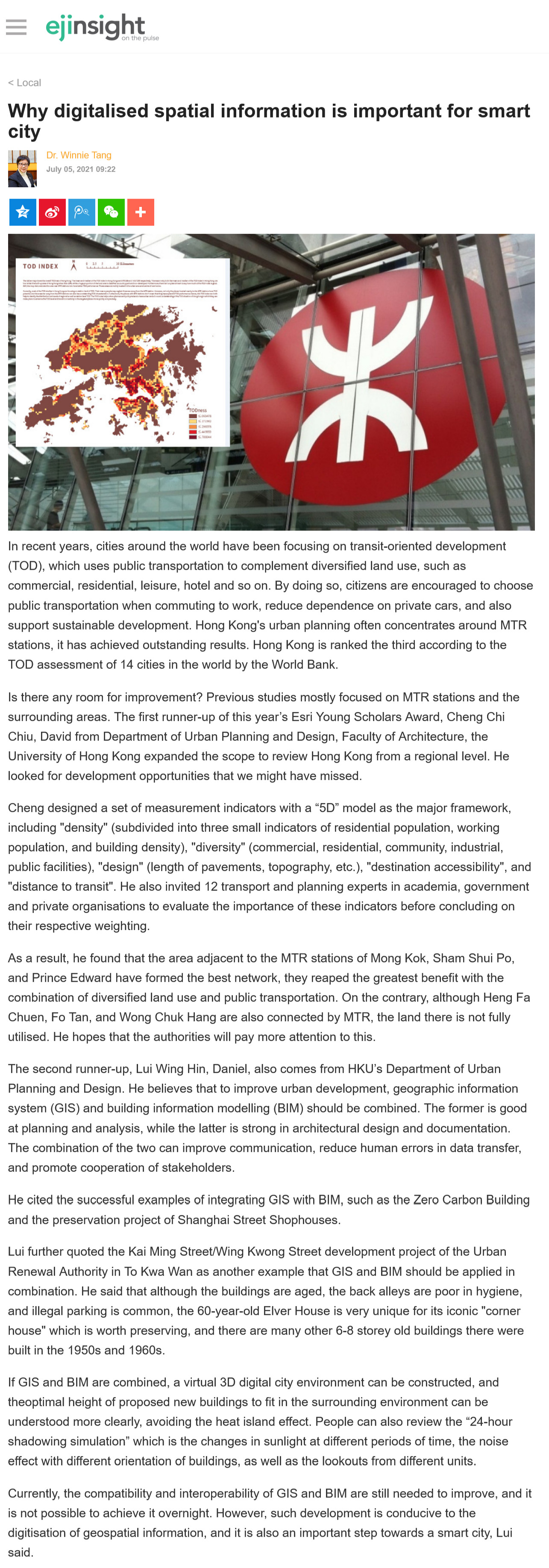網上版請按此

Why digitalised spatial information is important for smart city
In recent years, cities around the world have been focusing on transit-oriented development (TOD), which uses public transportation to complement diversified land use, such as commercial, residential, leisure, hotel and so on. By doing so, citizens are encouraged to choose public transportation when commuting to work, reduce dependence on private cars, and also support sustainable development. Hong Kong's urban planning often concentrates around MTR stations, it has achieved outstanding results. Hong Kong is ranked the third according to the TOD assessment of 14 cities in the world by the World Bank.
Is there any room for improvement? Previous studies mostly focused on MTR stations and the surrounding areas. The first runner-up of this year's Esri Young Scholars Award, Cheng Chi Chiu, David from Department of Urban Planning and Design, Faculty of Architecture, the University of Hong Kong expanded the scope to review Hong Kong from a regional level. He looked for development opportunities that we might have missed.
Cheng designed a set of measurement indicators with a "5D" model as the major framework, including "density" (subdivided into three small indicators of residential population, working population, and building density), "diversity" (commercial, residential, community, industrial, public facilities), "design" (length of pavements, topography, etc.), "destination accessibility", and "distance to transit". He also invited 12 transport and planning experts in academia, government and private organisations to evaluate the importance of these indicators before concluding on their respective weighting.
As a result, he found that the area adjacent to the MTR stations of Mong Kok, Sham Shui Po, and Prince Edward have formed the best network, they reaped the greatest benefit with the combination of diversified land use and public transportation. On the contrary, although Heng Fa Chuen, Fo Tan, and Wong Chuk Hang are also connected by MTR, the land there is not fully utilised. He hopes that the authorities will pay more attention to this.
The second runner-up, Lui Wing Hin, Daniel, also comes from HKU's Department of Urban Planning and Design. He believes that to improve urban development, geographic information system (GIS) and building information modelling (BIM) should be combined. The former is good at planning and analysis, while the latter is strong in architectural design and documentation. The combination of the two can improve communication, reduce human errors in data transfer, and promote cooperation of stakeholders.
He cited the successful examples of integrating GIS with BIM, such as the Zero Carbon Building and the preservation project of Shanghai Street Shophouses.
Lui further quoted the Kai Ming Street/Wing Kwong Street development project of the Urban Renewal Authority in To Kwa Wan as another example that GIS and BIM should be applied in combination. He said that although the buildings are aged, the back alleys are poor in hygiene, and illegal parking is common, the 60-year-old Elver House is very unique for its iconic "corner house" which is worth preserving, and there are many other 6-8 storey old buildings there were built in the 1950s and 1960s.
If GIS and BIM are combined, a virtual 3D digital city environment can be constructed, and theoptimal height of proposed new buildings to fit in the surrounding environment can be understood more clearly, avoiding the heat island effect. People can also review the "24-hour shadowing simulation" which is the changes in sunlight at different periods of time, the noise effect with different orientation of buildings, as well as the lookouts from different units.
Currently, the compatibility and interoperability of GIS and BIM are still needed to improve, and it is not possible to achieve it overnight. However, such development is conducive to the digitisation of geospatial information, and it is also an important step towards a smart city, Lui said.
Dr. Winnie Tang
Adjunct Professor, Department of Computer Science, Faculty of Engineering; Department of Geography, Faculty of Social Sciences; and Faculty of Architecture, The University of Hong Kong